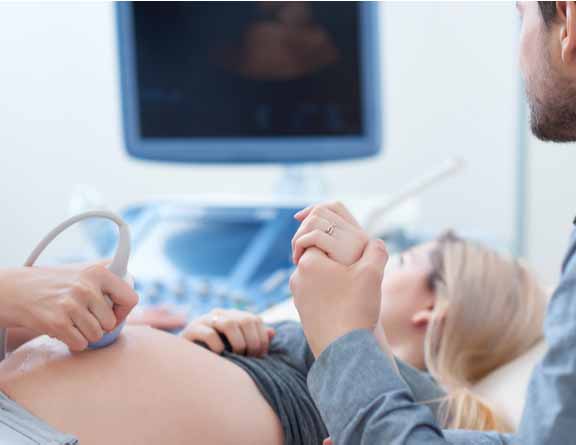
Delhi
Prenatal & Postpartum Care
Female Gynecologists
Free Doctor Consultation
No-cost EMI

Pregnancy is the most vital, beautiful, and sensitive phase in the life of a woman. Pregnancy care consists of two phases - antenatal, also known as prenatal care (before birth) and postnatal care (after birth) for the expectant mother and the baby. During the pregnancy, the gynecologist checks the mother and the baby regularly to ensure their proper health and a trouble free delivery.
Getting thoroughly diagnosed during the pregnancy is very important for both the baby and the mother. This involves medications and vaccinations for the best health of the mother and the baby, and even educating and counseling the mother about different aspects and how to handle those during the pregnancy. Pregnancy care, especially antenatal care in the hands of a professional gynecologist is important even if you think your pregnancy is going well, to identify and avoid and potential risks.


Pregnancy Care Treatment: Normal Delivery & Cesarean Delivery
A normal or vaginal delivery can be divided into different phases.
The early phase of labor begins with the rupture of the amniotic sac. This is often known as ‘water breaking.’ The amniotic sac usually remains intact until the delivery time. The gush of fluid that comes out after the water breaks should be colorless and odorless. If the color becomes green yellow , or brown, then doctor consultation is a must.
The uterus starts contracting and relaxing which pushes the baby out through the cervix. It can feel like heavy cramping at times. Contractions are not essentially a primary indicator of labor pain. But in case the contractions last for an hour or so, you need to understand that your labor has begun.
During the labor, the cervix facilitates in delivering the baby. The cervix is the lowest part of the uterus that opens into the vagina. It dilates and opens enough to allow the baby to pass out. The cervical canal opens up to 10 cms to let the baby pass into the birth canal. Once the baby enters the vagina, the muscles and the skin get stretched. The labia and the perineum also opens to the maximum point. If the mother experiences terrible burning sensation, the doctor may decide to intently perform an incision of the vaginal opening to fasten the delivery and to relieve the mother of the pain. This process is known as episiotomy.
By this time, the head of the baby should come out. Although the pain and pressure subsides by now, the discomfort will still remain. The doctor and nurse will ask you to push the baby gently till the baby emerges into the world.
The final stage involves delivering the placenta. This might take a few minutes to half an hour. Your healthcare provider will inspect the placenta to make sure if it was delivered completely or not.
The obstetrician prepares for a C-section or cesarean delivery by using anesthesia to numb the lower part of the body. Your abdomen will be cleaned with an antiseptic solution and then shaved. The obstetrician, using a knife will make an incision in the abdominal wall. After the abdomen, another incision is made in the uterus. A side-to-side cut is also made to rupture the amniotic sac. The baby is taken out of the uterus, the doctors cut the umbilical cord and then delivers the placenta.
Once the delivery is over, the doctors stitch back the incisions using dissolvable stitches. After the surgery, the mother is kept under supervision and medications at a maternity ward.


 NABH
NABH
Pristyn Care Elantis is dedicated to revolutionising surgical care. We combine the latest medical technology with highly skilled professionals and a patient-centric approach to transform the healthcare experience. Our team of doctors at Pristyn Care Elantis, strives to simplify the entire patient journey, ensuring a seamless process from diagnosis through recovery.
We offer specialised treatments across a wide range of medical fields, including proctology, laparoscopic surgery, ENT (ear, nose, and throat), vascular, gynaecology, urology, aesthetics, orthopaedics, ophthalmology, and weight loss solutions.
The Suites & Rooms at Pristyn Care Elantis are designed with your comfort in mind, offering a welcoming ambiance and top-notch amenities to make your stay as pleasant as possible.
Our highly skilled medical team, supported by advanced infrastructure, makes us a trusted choice for comprehensive healthcare solutions.
...Read More


 NABH
NABH
Pristyn Care Sheetla Hospital in Gurgaon makes quality healthcare more accessible and personal. The hospital offers advanced treatment across various specialties like women’s health, child and neonatal care, etc. and minimally invasive surgery. With 36 well-equipped beds, 3 modern operation theatres, and a dedicated ICU, Pristyn Care Sheetla works with comfort and efficiency. With 90+ experienced doctors and a courteous professional medical team, we ensure clear communication, personalized care, and real results – so you feel supported every step of the way.
...Read More
Delivering Seamless Surgical Experience in India
Your safety is taken care of by thermal screening, social distancing, sanitized clinics and hospital rooms, sterilized surgical equipment and mandatory PPE kits during surgery.
A dedicated Care Coordinator assists you throughout the surgery journey from insurance paperwork, to free commute from home to hospital & back and admission-discharge process at the hospital.
Our surgeons spend a lot of time with you to diagnose your condition. You are assisted in all pre-surgery medical diagnostics. We offer advanced laser and laparoscopic surgical treatment. Our procedures are USFDA approved.
We offer free follow-up consultations and instructions including dietary tips as well as exercises to every patient to ensure they have a smooth recovery to their daily routines.
During the pregnancy, you should refrain from taking any over-the-counter medicines. If you are having any health related issues, you should always consult with obstetrician and take only medicines which are prescribed.
As long as you don’t have any serious complications, you can take short journeys. Many times, during the trip, you can feel dizzy and vomiting. You might also easily get fatigued.
Pristyn Care in Delhi NCR provides the best pregnancy care which includes both antenatal and postnatal care services. With the help of our specialized gynecologists, the mother will be provided the best medication, treatment and physiotherapy to ensure the best health of the baby. If you are planning to conceive or need any medical help during the pregnancy, visit us for the best obstetrics services.
The gynecologists at Pristyn Care, Delhi NCR are experienced enough to provide you the best pregnancy care. They will diagnose you, help you with medicines and exercises and recommend the best lifestyle practices to ensure your good health and that you deliver a healthy baby. Obstetrics services available at our clinics are considered to be one of the best in the city. If you are an expecting mother, or know anyone who is planning for a baby, you can visit us for the best obstetric services or pregnancy care.
| Sr.No. | Doctor Name | Ratings | Experience | Address | Book Appointment |
|---|---|---|---|---|---|
| 1 | Dr. Ila Gupta | 4.6 | 33 + Years | 12, Navjeevan Vihar, Malviya Nagar, New Delhi |
Book Appointment |
| 2 | Dr. Monika Dubey | 5.0 | 24 + Years | G-32, Tulsi Marg, Sector 27, Noida |
Book Appointment |
| 3 | Dr. Priyanka | 4.6 | 15 + Years | 12, Navjeevan Vihar, Malviya Nagar, New Delhi |
Book Appointment |
| 4 | Dr. Mannan Gupta | 5.0 | 15 + Years | 29, Ring Road, Block L, Lajpat Nagar, New Delhi |
Book Appointment |
| 5 | Dr. Priya Shikha Modi | 4.6 | 15 + Years | -- |
Book Appointment |
| 6 | Dr. Maincy Devediya | 4.6 | 15 + Years | -- |
Book Appointment |
| 7 | Dr. Pooja Bajaj Wadhwa | 4.6 | 14 + Years | 12, Navjeevan Vihar, Malviya Nagar, New Delhi |
Book Appointment |
| 8 | Dr. Preeti Mehra | 4.6 | 14 + Years | -- |
Book Appointment |
| 9 | Dr. Swati Chhabra | 4.6 | 8 + Years | -- |
Book Appointment |
Pushpa Bansal
Recommends
.Pristyn Care's pregnancy care team was compassionate and attentive. They made sure I felt safe and reassured at every step of my pregnancy..
Neeroo Kadam
Recommends
Pristyn Care's pregnancy care was wonderful and helpled me remain at so much ease! They provided comprehensive support throughout my pregnancy, from regular check-ups to helpful advice. Highly recommend their services..
Marutanjali Patnaik
Recommends
.Choosing Pristyn Care for my pregnancy care was the best decision. The staff was friendly, and the doctors made me feel comfortable and well-informed..
Kaavya Dey
Recommends
.The doctors at Pristyn Care were not only highly skilled but also genuinely caring. They went above and beyond to ensure my pregnancy was smooth and healthy..
.svg)
.svg)